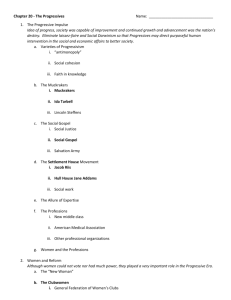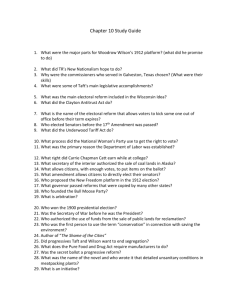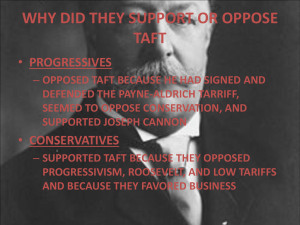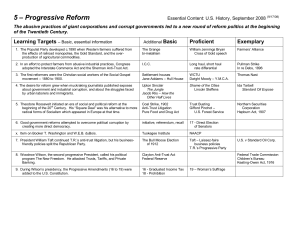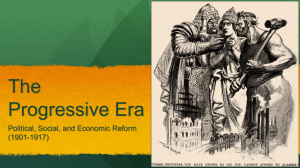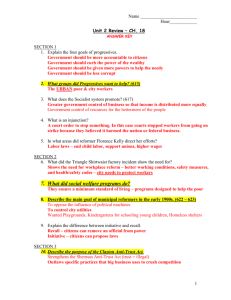File
advertisement
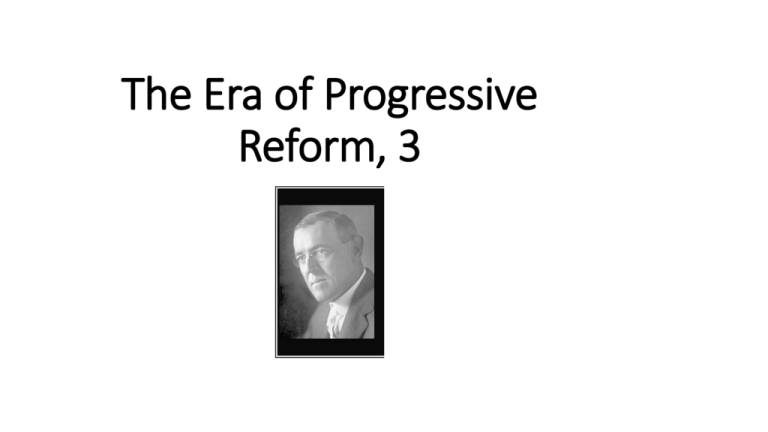
The Era of Progressive Reform, 3 IIII. Election of 1912 - Break up of Republican Party A. Division in GOP 1. TR in Africa (1909-1910) 2. Taft allied with Old Guard a. TR felt Taft resisted reform b. “Intelligent but limited imagination” B. TR return in 1910 1. TR grew unhappy in Africa 2. Speaking tour a. Moved further left & from Taft 1. “New Nationalism” – more gov’t C. The Election of 1912 1. Stormy Republican convention a. Angry at Taft over conservation, and reform b. “My hat is in the ring and I want it back.” c. Brutal primary campaign 1. TR more popular in primaries a. Taft “frustrated and abandoned” b. But Taft controlled the Republican convention. c. Southern Republicans support Taft 2. Third party - Progressives a. H. Croley b. New Nationalism i. Powerful government to control trusts ii. Major social reforms 3. Democratic - Wilson the Progressive a. Personality i. Cool and scholarly ii. Professorial b. “New Freedom” - Keep gov’t small- Break up trusts c. Real race between WW and TR—Taft was out i. Public concern about industrialization and reform ii. Both wanted reform - TR - Regulate with large government - WW - Break them up 4. Wilson wins with 40% popular vote a. TR hurt Progressive movement b. Republicans became conservative “stand-pat” party c. Progressives now looking for a leader IV. Wilson’s first term, New Freedom in Action 1. Amendments a. 16th Amendment (1913) b. 17th Amendment (1913) c. 18th Amendment (1919) d. 19th Amendment (1920) 2. Legislation a Underwood Tariff-Reduce rates (1913) b. Federal Reserve Act (1913) a. Regional banks b. Provided for “elastic currency” 3. FTC (1914) (Similar to New Nationalism) a. Consumer protection b. Regulation of business 4. Clayton Antitrust Act (1914) a. Prohibit monopolies b. Forbid “unfair trade.” c. Exempts unions from Sherman B. Surprisingly he stopped. 1. Not help farmers, workers, child labor 2. Against union exemption from anti-trust laws 3. Opposed women vote 4. Progressives grumble. C. Conservative reaction 1. Support concept of individualism - Liberty a. Lockean – Secure and Protect Certain Property 2. Oppose Progressive govt protection - Equal op. a. Want markets b. Want tariffs and labor policing D. Progressives & minority rights a. "Gentlemen's Agreement" (1907) b. Dillingham Commission (1907-1911) - Leads To immigration reform (1921-1924) - Precedent for 1930-1944 “Repatriation” c. African Americans (1906-1921) 1. Segregated Gov’t, D. C. (1914-1918) 2. Ignored increased lynching V. Social and Cultural Histories of Progressivism A. Native Americans 1. Large differences between sovereign nations and not 2. Society of American Indians (1910-1923) a. Carlos Montezuma and Zitkala Sa b. Laura Cornelius Kellogg c. 1924 – Native American Citizenship B. African American Progressive Organization 1. 1910-1930, Great Migration and Organization a. 1900 – 90% African-Americans in South b. 1930 – 2M African-Americans in N/W c. South in the North, Cultural Composites i. Racism and Cultural Production ii. Ragtime, Jazz, Blues, Rock iii. As “threat,” “aliens” AND black 2. Fraternal Organizations a. “Self Help” from Reconstruction Onward 3. UNIA, Marcus Garvey (1914-1925) a. Politics – Separatism, Cooperation b. Culture – Afrocentrism, diasporic solidarity 4. Discrimination, Racist Terrorism, and State Violence a. Democratic Party Monopoly b. White jobs v. black jobs c. Relief and school funds d. Law enforcement and criminal justice - Rape of blacks: “I have serious doubts as to whether ..” - Reform of Convict Lease System Begins e. Lynching i. “Death by persons unknown.”- No ind. responsibility ii. 1898-1908, Wilmington, Atlanta, and Springfield, IL - Atlanta riots show B. Washington fail iii. 1919 – Red Summer – Lynching of US soldiers/veterans - From Omaha, NE, to Elaine, AR iv. Self-help v. self-defense - Washington v. DuBois - White rifle clubs v. armed black US veterans - Gun control - State seizures of guns of blacks - 1909, NAACP, 1905 Niagara Movement - Multi-racial group for racial equality - Were civil rights a radical demand? C. WASP Revival 1. 1909 – Hugh Dixon, The Klansmen 2. 1915, Madison Grant, Passing of a Great Race 3. 1915 – DW Griffith - Birth of a Nation 4. 1915 – Refoundation of the KKK, Stone Mt., GA a. “Pure Americanism” i. Anti-Catholic, Anti-Semitic, “Pro-white” b. Religious – Defending Christianity in the US i. 2/3rds ministers, Baptist, Methodist - Enforces prohibition c. Regional Variations i. Asians and Mexican-Americans in West ii. African Americans and Jews in North and Midwest - Still violent d. Immensely popular -3 million members [Editor: I was wrong! Garraty, and Gilmore and Sugrue say 4-5 million members at height!] e. Sponsors candidates/children and women D. Progressive Moral reform 1. Prostitution a. Women as target b. “White slavery” c. Destroying the race d. Mann Act (1910) i. Jack Johnson (1912) e. Vice squads, policing of sexuality 2. Temperance - a. Prohibition proceeds on local level i. WCTU, Anti-Saloon League b. Immigrants and African-American Blamed i. Whisky Rebellion? ii. Local studies suggest otherwise c. Moral Panic D. Progressive Moral reform 3. Police reform a . Counteract Strikes and new violence i. Chicago - Adler, Force and respect - 1910s – 2.8%, 21% b. Vice squads and moral policing 4. Drugs, Moral Panic, and Race a. Drugs widespread in patent medicine i. Heroin, opium, morphine, cocaine ii. By 1910s, associated by journalists to racial minorities - Reefer madness - Victims and Fiends iii. By 1960s – Monsters in barrios and ghettoes. - Victims in suburbs D. Practical Science and Segregation 1. Social Sciences, Order, and Education a. Race, like Intel. and cultural traits, all heritable b. Differences between SD and religious view of race i. Science shows one as racially inferior ii. “God made you racially inferior” b. Criminology and Intelligence i. European Criminologists deem skull measurements , intelligence, and criminality to be connected and heritable c. Positive and Negative Eugenics (1899-1917) i. + = People with cleverness and good genes promoted, add to pop. ii. - = People of lower intel. discouraged from reproducing or sterilized - Indiana starts sterilization of “feebleminded” in 1907 - (1912) Cal. Passes laws that allow sterilization of “feebleminded” - CA sterilizes 20k of 60k total starting in 1912

